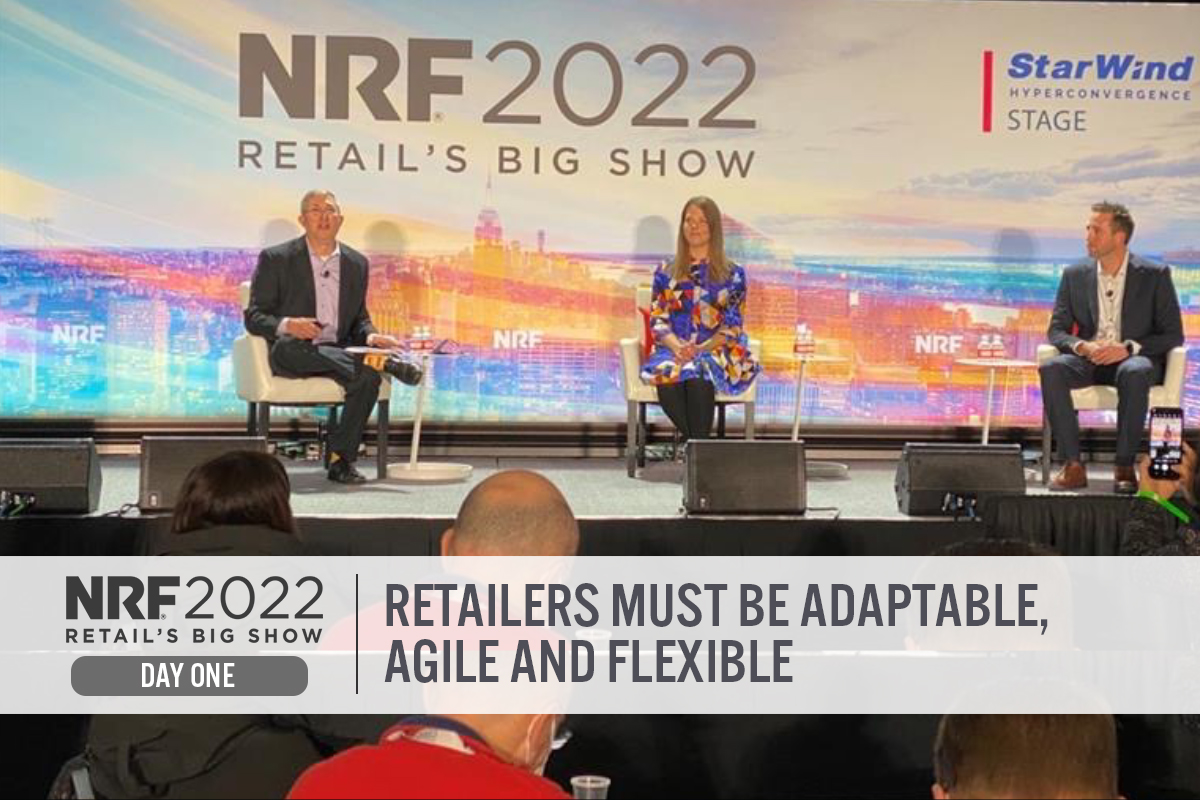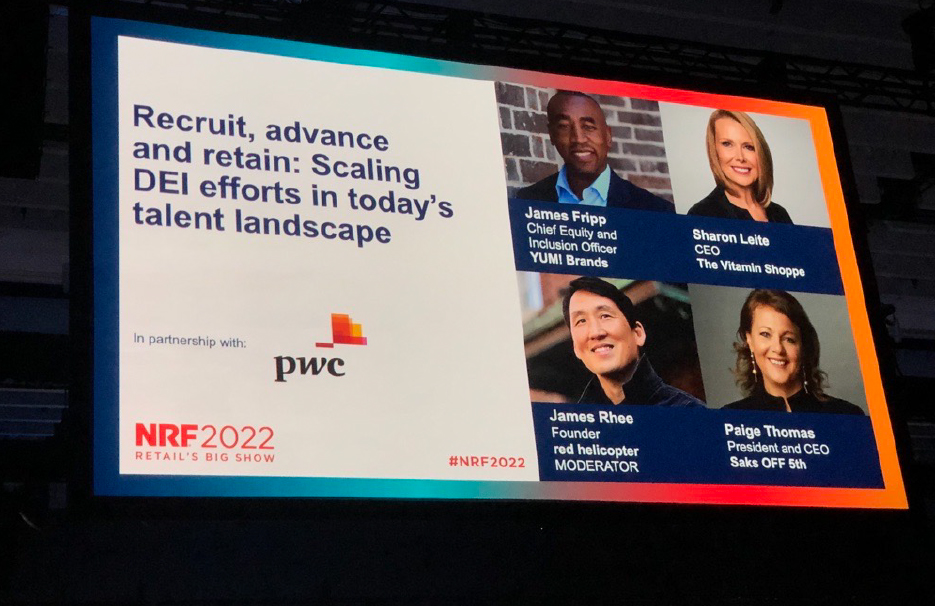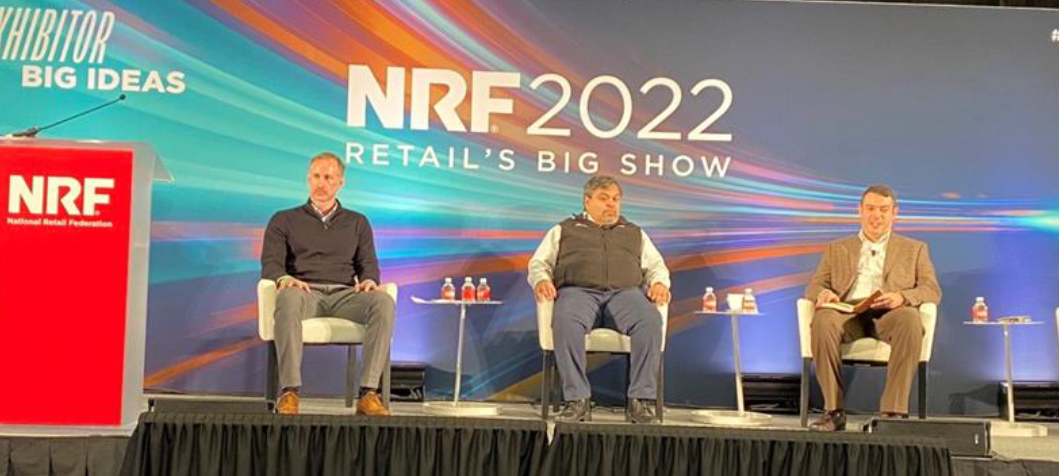
DIpil Das
The Coresight Research team is attending NRF 2022: Retail’s Big Show in New York City, US, from January 16 to 18. The event, hosted by the National Retail Federation (NRF) brings together retail technology innovators, industry experts, brands and retailers to participate in panel discussions, present on key topics in retail and showcase their solutions.
In this report, we present our top insights from day one of the show on January 16, 2022.
 Source: Coresight Research [/caption]
Target Emphasizes the Importance of Agility, Flexibility and Adaptability
Target, and much of the retail industry, has begun to emerge stronger out of the Covid-19 pandemic thanks to an emphasis on agility, flexibility and adaptability, according to Brian Cornell, Chairman and CEO at Target. He said that the retailer remains optimistic: Consumers continue to show up and shop all categories and all channels, proving that retail is a “really important part” of their daily life. He emphasized that agility, flexibility and adaptability helped Target not only weather the pandemic but also emerge stronger from it. Cornell explained that Target could remain agile and adaptable due to its earlier investments in these values.
Cornell termed the 22 months of the pandemic (March 2020 to date) a “unique headwind” that still persists in three forms:
Source: Coresight Research [/caption]
Target Emphasizes the Importance of Agility, Flexibility and Adaptability
Target, and much of the retail industry, has begun to emerge stronger out of the Covid-19 pandemic thanks to an emphasis on agility, flexibility and adaptability, according to Brian Cornell, Chairman and CEO at Target. He said that the retailer remains optimistic: Consumers continue to show up and shop all categories and all channels, proving that retail is a “really important part” of their daily life. He emphasized that agility, flexibility and adaptability helped Target not only weather the pandemic but also emerge stronger from it. Cornell explained that Target could remain agile and adaptable due to its earlier investments in these values.
Cornell termed the 22 months of the pandemic (March 2020 to date) a “unique headwind” that still persists in three forms:
 Connect with a Vet
Connect with a Vet
Source: Company website [/caption] Localization Is Key When Expanding to DTC Ish Patel, COO of Digital at Victoria’s Secret, and Patrick Bousquet-Chavanne, President and CEO, Americas at DTC (direct-to-consumer) e-commerce solutions provider ESW, discussed how Victoria’s Secret has accelerated its DTC offering from five international markets in 2014 to over 60 countries today. Patel said that understanding the market and “the size of the prize” is of upmost importance, because some markets are more important than others. Bousquet-Chavanne said that today, it is not an option of whether brands should adopt DTC; it is a matter of where. Brand considerations include the cost to serve, complexity, payments, compliance and loyalty. As each new geographic site is added, more complexity is added. Patel said that brands should always put themselves up to a localization test, and Bousquet-Chavanne added that at the heart of success is to put one’s brand to the standards of the best local players—across language, checkout, payment, returns and logistics. A brand has to come up with a native feel and offer the same convenience and localization of content of competing players. Patel and Bousquet-Chavanne emphasized that the checkout process is an incredibly important part of the consumer experience as this is a “trust conversation” between a brand and the consumer—with customers questioning if the brand will fulfill its promise to deliver on time, for example. Brands can build a consumer’s trust by making the checkout process on-brand, fast and convenient, such as by offering local payment options. Sustainability in Retail Requires Expertise and Cooperation “You don’t need to start at ‘zero’ to reach net zero emissions if you build cooperation among stakeholders”: This is how Scot Case, Vice President of Corporate Social Responsibility and Sustainability at NRF summed up the forum on sustainability. Walmart plans to achieve net zero emissions by 2040, but the complex network of suppliers, partners and contractors has tied Walmart’s sustainability fate to the rest of the retail industry, according to Zach Freeze, Senior Director of Sustainability at the company. Indeed, supply chains are responsible for 95% of Walmart’s carbon footprint, he said. About 15 years ago, when Walmart inaugurated its first energy-renewal program, it formed a council of external experts to identify “what the company had to do and what it should not,” Freeze noted. With the assistance of outside expertise and the company’s own commitment, more than 3,000 suppliers are now part of the program, up from an initial 300. Saskia van Gendt, Head of Sustainability at Rothy’s, a manufacturer of washable shoes and bags, said that the company also engaged outside expertise to roadmap its idea of circularity—designing products to reduce waste and improve durability and longevity. She emphasized the importance of a collaborative approach. Rothy’s sets medium targets and tries to be as practical as possible, with shared values that are good for business and society, van Gendt said. The company’s current three-year goal is focused on circular production and carbon neutrality. Freeze highlighted that all parties involved must be inspired to be held accountable. Walmart sets a practical minimum target based on shared values to facilitate cooperation and inspiration. “The goal should be very specific for a long-term net zero,” said Freeze. Walmart understands sustainability as an innovation, enabling the company to stand out by putting sustainability at the forefront. [caption id="attachment_139574" align="aligncenter" width="725"] From left to right: Scot Case, Saskia van Gendt and Zack Freeze
From left to right: Scot Case, Saskia van Gendt and Zack Freeze
Source: Coresight Research [/caption] Existing Data Is the Building Block for Using AI The Exhibitor Big Ideas session, “Applying AI at Scale in Large Organizations,” produced by Impact Analytics, aimed to help retailers understand the power of AI (artificial intelligence) and ML (machine learning), and the ways in which this technology can help support retail operations. Chris DeFuria, Senior Director of Global Analytics at Tapestry, and Juan Hernandez, Director of Omnichannel Pricing at Dick's Sporting Goods, discussed applying AI at scale at their firms with Prashant Agrawal, CEO and Founder of Impact Analytics. AI can improve demand forecasting and forecasting accuracy; drive lifecycle product promotions and clearance/end-of-life/none-go-forward product decisions; improve consumer segmentation; and even inform new fashion assortments, for example. Hernandez explained that, when using AI, retailers must isolate the problem they want AI to solve and determine whether they have high-quality and accessible data. If AI is well suited to solving the problem, the challenges of implementation are similar to other people, process and systems project executions. Often, firms are intimidated by AI and worry about their data. Agrawal said that they should just start with the data they have: “It is never perfect; you can start with dirty data. AI is a journey, not a destination or a magic pill.” Hernandez said that Dick’s Sporting Goods encountered difficulties trying to solve numerous problems simultaneously—spanning item-level productivity to using AI to handle other merchants, building an approval system and forecasting across 56 different buying teams within the company. Defining the problem that drives the most value is the best place to start, he said. Dick’s is in the early stages of using AI with pricing and expects that, by demonstrating the value of using science internally, it will be gradually employed across the organization. Agrawal also addressed retail executives’ reluctance to turn over decisions to a “black box.” AI is relatively new, and Tapestry (a modern luxury company consisting of Coach, Kate Spade and Stuart Weitzman) is partnering with vendors to implement AI at scale, while experimentation is done by the internal data team to test, learn and identify the best opportunities. In this way, Tapestry is seeing the results of a “black box” in allocation, and forecasting accuracy has improved as a result. [caption id="attachment_139575" align="aligncenter" width="701"] From left to right: Chris DeFuria, Prashant Agrawal and Juan Hernandez
From left to right: Chris DeFuria, Prashant Agrawal and Juan Hernandez
Source: Coresight Research [/caption] Blockchain Will Be the Future of Authenticity In his keynote session, “Reshaping Retail with Technology,” Arvind Krishna, Chairman at IBM, declared that blockchain is the future of authenticity and provides unprecedented data security. Blockchain technology is an electronically distributed ledger that removes the need for manual processing and authentication by intermediaries. Furthermore, individuals are not able to alter stored data without alerting the entire system, eliminating any likelihood for fraudulent activity. Krishna believes that blockchain is going to be an essential technology within the supply chain in the near future. In maritime shipping, “around $20 billion is spent on paper and moving paper around” to manually authenticate shipping orders, he said. Blockchain, on the other hand, would enable paperless authenticity within the supply chain—not only saving money but providing a more sustainable solution for shipping authenticity.
NRF 2022 Day One: Coresight Research Insights
There Is a Willingness To Embrace Change “Two years of willingness to embrace change has kept the economy moving forward,” declared NRF Chairman Michael George in his keynote speech marking the beginning of NRF 2022. According to the NRF, US retail sales in the November–December holiday season posted growth of 14.1% year over year in 2021, reaching $886.7 billion, despite ongoing difficulties such as inflationary pressures, supply chain challenges and labor shortages. George stated that in-store sales and foot traffic saw increases of 14% and 18%, respectively, in the same time frame—with balanced and broad growth representing a positive sign following the heavy impacts of the Covid-19 pandemic from April 2020. George defined an “integrated shopping experience” as the new normal. The pandemic accelerated the adoption of technology by a year at least, he said, and the use of technology is extending include local and small shops. However, he emphasized the tight labor market conditions continue, and congested and bottlenecked logistics and inflationary pressures are ongoing concerns for US retail. Dedication, passion and adaptability will predicate the success of the industry, George concluded. Reverse Mentoring and Removing Employee Burdens Are Effective DEI Strategies In the panel, “Recruit, Advance and Retain: Scaling DEI Efforts in Today’s Talent Landscape,” panelists discussed diversity, equity and inclusion (DEI) in the workplace today. Jason Fripps, Chief Equity and Inclusion Officer at Yum! Brands (one of the largest fast-food restaurant franchises with over 40,000 stores), said that the company is using multicultural Employee Resource Groups, and that these are working out very well. Fripps said that the purpose of the groups is to solve issues for others and help individuals to understand the issues and challenges that others are facing. Yum! Brands also has a reverse mentorship program. Fripps said that people of color and women are overly mentored and under-sponsored. In a reverse mentor situation, the leader is responsible for learning about their mentee. Fripps emphasized that the goal of these relationships is for the individuals to achieve a deeper understanding of each other. The importance of having conversations with employees, gaining a deeper understanding of what employees want and need, and really becoming more in tune with what makes employees “tick” was echoed by panelists Paige Thomas, President and CEO of Saks Off Fifth and Sharon Leite, CEO of The Vitamin Shoppe. Thomas said that DEI is about having open conversations with employees; Saks Off Fifth conducted in-house surveys that resulted in a hybrid work schedule, because the company found that flexibility was paramount to its employees. Leite said that the main reason that employees quit their jobs is because they do not like their boss, so engagement and having a connection with the people you work with and for is important. Fripps added that Yum! Brands provides bus passes and day care to alleviate the burdens of daily life for its employees. [caption id="attachment_139572" align="aligncenter" width="700"] Source: Coresight Research [/caption]
Target Emphasizes the Importance of Agility, Flexibility and Adaptability
Target, and much of the retail industry, has begun to emerge stronger out of the Covid-19 pandemic thanks to an emphasis on agility, flexibility and adaptability, according to Brian Cornell, Chairman and CEO at Target. He said that the retailer remains optimistic: Consumers continue to show up and shop all categories and all channels, proving that retail is a “really important part” of their daily life. He emphasized that agility, flexibility and adaptability helped Target not only weather the pandemic but also emerge stronger from it. Cornell explained that Target could remain agile and adaptable due to its earlier investments in these values.
Cornell termed the 22 months of the pandemic (March 2020 to date) a “unique headwind” that still persists in three forms:
Source: Coresight Research [/caption]
Target Emphasizes the Importance of Agility, Flexibility and Adaptability
Target, and much of the retail industry, has begun to emerge stronger out of the Covid-19 pandemic thanks to an emphasis on agility, flexibility and adaptability, according to Brian Cornell, Chairman and CEO at Target. He said that the retailer remains optimistic: Consumers continue to show up and shop all categories and all channels, proving that retail is a “really important part” of their daily life. He emphasized that agility, flexibility and adaptability helped Target not only weather the pandemic but also emerge stronger from it. Cornell explained that Target could remain agile and adaptable due to its earlier investments in these values.
Cornell termed the 22 months of the pandemic (March 2020 to date) a “unique headwind” that still persists in three forms:
- Supply chain challenges—Cornell proposed two different approaches to supply chain challenges. In the short term, data transparency must improve, allowing logistics data and analytics to be shared more promptly and efficiently to reduce port bottlenecks and truck shortages. In the long term, US infrastructure should be updated, as pursued by the recent $1.2 trillion infrastructure financing package.
- Inflationary pressures—Cornell said the upward pressure on cost would not only call for retail response but also reshape consumer behavior. To better respond to inflationary pressures, consumers would likely favor generic brands over national brands, he noted.
- Labor shortages—Cornell vented frustration when he began his remarks on the labor shortage by saying, “We need more truck drivers.” He said that Target has been pursuing care, growth and winning together to retain talent.
- Connect with a Vet—Vet telehealth did not exist approximately 15 months ago. Chewy created this solution in October 2020 to enable consumers to connect with a veterinarian either through instant chat or through video chat. Singh said that there is a lack of consumer education and awareness on the consumer side, as many consumers do not take their pets to a vet regularly; the solution helps consumers to conveniently and easily connect with a vet and receive expert guidance around pet-related concerns, from nutritional and supplemental support to emergency guidance with questions regarding illness.
- Practice Hub—Chewy launched an online pharmacy platform for veterinarians in September 2021. Practice Hub provides vets with a complete e-commerce solution for their clients, leveraging the benefits of Chewy’s quick and reliable delivery, customer care team and Autoship subscription service. Veterinarians can set prices, create pre-approved prescriptions and earn revenue when customers place an order in-clinic or on Chewy.com. Singh said that the platform enables veterinarians to focus on their practice while Chewy handles the back-end logistics.
 Connect with a Vet
Connect with a Vet Source: Company website [/caption] Localization Is Key When Expanding to DTC Ish Patel, COO of Digital at Victoria’s Secret, and Patrick Bousquet-Chavanne, President and CEO, Americas at DTC (direct-to-consumer) e-commerce solutions provider ESW, discussed how Victoria’s Secret has accelerated its DTC offering from five international markets in 2014 to over 60 countries today. Patel said that understanding the market and “the size of the prize” is of upmost importance, because some markets are more important than others. Bousquet-Chavanne said that today, it is not an option of whether brands should adopt DTC; it is a matter of where. Brand considerations include the cost to serve, complexity, payments, compliance and loyalty. As each new geographic site is added, more complexity is added. Patel said that brands should always put themselves up to a localization test, and Bousquet-Chavanne added that at the heart of success is to put one’s brand to the standards of the best local players—across language, checkout, payment, returns and logistics. A brand has to come up with a native feel and offer the same convenience and localization of content of competing players. Patel and Bousquet-Chavanne emphasized that the checkout process is an incredibly important part of the consumer experience as this is a “trust conversation” between a brand and the consumer—with customers questioning if the brand will fulfill its promise to deliver on time, for example. Brands can build a consumer’s trust by making the checkout process on-brand, fast and convenient, such as by offering local payment options. Sustainability in Retail Requires Expertise and Cooperation “You don’t need to start at ‘zero’ to reach net zero emissions if you build cooperation among stakeholders”: This is how Scot Case, Vice President of Corporate Social Responsibility and Sustainability at NRF summed up the forum on sustainability. Walmart plans to achieve net zero emissions by 2040, but the complex network of suppliers, partners and contractors has tied Walmart’s sustainability fate to the rest of the retail industry, according to Zach Freeze, Senior Director of Sustainability at the company. Indeed, supply chains are responsible for 95% of Walmart’s carbon footprint, he said. About 15 years ago, when Walmart inaugurated its first energy-renewal program, it formed a council of external experts to identify “what the company had to do and what it should not,” Freeze noted. With the assistance of outside expertise and the company’s own commitment, more than 3,000 suppliers are now part of the program, up from an initial 300. Saskia van Gendt, Head of Sustainability at Rothy’s, a manufacturer of washable shoes and bags, said that the company also engaged outside expertise to roadmap its idea of circularity—designing products to reduce waste and improve durability and longevity. She emphasized the importance of a collaborative approach. Rothy’s sets medium targets and tries to be as practical as possible, with shared values that are good for business and society, van Gendt said. The company’s current three-year goal is focused on circular production and carbon neutrality. Freeze highlighted that all parties involved must be inspired to be held accountable. Walmart sets a practical minimum target based on shared values to facilitate cooperation and inspiration. “The goal should be very specific for a long-term net zero,” said Freeze. Walmart understands sustainability as an innovation, enabling the company to stand out by putting sustainability at the forefront. [caption id="attachment_139574" align="aligncenter" width="725"]
 From left to right: Scot Case, Saskia van Gendt and Zack Freeze
From left to right: Scot Case, Saskia van Gendt and Zack Freeze Source: Coresight Research [/caption] Existing Data Is the Building Block for Using AI The Exhibitor Big Ideas session, “Applying AI at Scale in Large Organizations,” produced by Impact Analytics, aimed to help retailers understand the power of AI (artificial intelligence) and ML (machine learning), and the ways in which this technology can help support retail operations. Chris DeFuria, Senior Director of Global Analytics at Tapestry, and Juan Hernandez, Director of Omnichannel Pricing at Dick's Sporting Goods, discussed applying AI at scale at their firms with Prashant Agrawal, CEO and Founder of Impact Analytics. AI can improve demand forecasting and forecasting accuracy; drive lifecycle product promotions and clearance/end-of-life/none-go-forward product decisions; improve consumer segmentation; and even inform new fashion assortments, for example. Hernandez explained that, when using AI, retailers must isolate the problem they want AI to solve and determine whether they have high-quality and accessible data. If AI is well suited to solving the problem, the challenges of implementation are similar to other people, process and systems project executions. Often, firms are intimidated by AI and worry about their data. Agrawal said that they should just start with the data they have: “It is never perfect; you can start with dirty data. AI is a journey, not a destination or a magic pill.” Hernandez said that Dick’s Sporting Goods encountered difficulties trying to solve numerous problems simultaneously—spanning item-level productivity to using AI to handle other merchants, building an approval system and forecasting across 56 different buying teams within the company. Defining the problem that drives the most value is the best place to start, he said. Dick’s is in the early stages of using AI with pricing and expects that, by demonstrating the value of using science internally, it will be gradually employed across the organization. Agrawal also addressed retail executives’ reluctance to turn over decisions to a “black box.” AI is relatively new, and Tapestry (a modern luxury company consisting of Coach, Kate Spade and Stuart Weitzman) is partnering with vendors to implement AI at scale, while experimentation is done by the internal data team to test, learn and identify the best opportunities. In this way, Tapestry is seeing the results of a “black box” in allocation, and forecasting accuracy has improved as a result. [caption id="attachment_139575" align="aligncenter" width="701"]
 From left to right: Chris DeFuria, Prashant Agrawal and Juan Hernandez
From left to right: Chris DeFuria, Prashant Agrawal and Juan Hernandez Source: Coresight Research [/caption] Blockchain Will Be the Future of Authenticity In his keynote session, “Reshaping Retail with Technology,” Arvind Krishna, Chairman at IBM, declared that blockchain is the future of authenticity and provides unprecedented data security. Blockchain technology is an electronically distributed ledger that removes the need for manual processing and authentication by intermediaries. Furthermore, individuals are not able to alter stored data without alerting the entire system, eliminating any likelihood for fraudulent activity. Krishna believes that blockchain is going to be an essential technology within the supply chain in the near future. In maritime shipping, “around $20 billion is spent on paper and moving paper around” to manually authenticate shipping orders, he said. Blockchain, on the other hand, would enable paperless authenticity within the supply chain—not only saving money but providing a more sustainable solution for shipping authenticity.